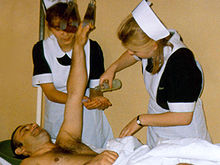- Nurse's cap
-
A nurse's cap or nursing cap is part of the female nurse's uniform, introduced early in the history of the profession. The cap's original purpose was to keep the nurse's hair neatly in place and present a modest appearance. Male nurses do not wear caps.
In some schools, a capping ceremony presents new nursing students their caps before beginning their clinical (hospital) training.
Contents
History
The nurse's cap was derived from the nun's habit and developed over time into two types:
- A long cap, that covers much of the nurse's hair, and
- A short cap, that sits atop the nurse's hair (common in the United Kingdom).
The nursing cap was originally used by Florence Nightingale in the 1800s.
Advantages
The nursing cap is a nearly universally recognized symbol of nursing. It allows patients to quickly identify a nurse in the hospital from other members of the health team.
Disadvantages
Some claim the cap is a potential carrier of bacteria and other disease-causing pathogens that could then be transmitted from patient to patient.[1] However, such incidents can be prevented when infection control procedures are followed.
Nurses' caps since the 1980s
The use of nurses' caps in the medical facilities of the United States (as well as many other nations) all but disappeared by the late 1980s with the near universal adoption of "scrubs." Also, the rapid growth of the number of men in nursing also necessitated a unisex uniform. However, nurses' caps can still be found in many developing nations, as well as some countries where women still make up the overwhelming majority of nurses.
References
- ^ Image, Function, and Style: A history of the nursing uniform. AJN, American Journal of Nursing. 104(4):40-48, April 2004.
Related pages
External links
Categories:- Nursing
- Nursing stubs
- Clothing stubs
Wikimedia Foundation. 2010.


